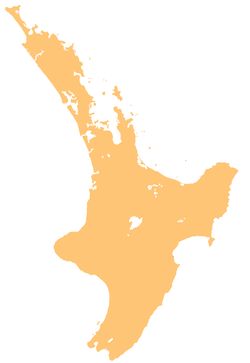Te Kohanga | |
|---|---|
| Coordinates: 37°18′50″S 174°50′44″E / 37.313906°S 174.845679°E | |
| Country | New Zealand |
| Region | Waikato |
| District | Waikato |
| Population (2013) | |
| • Total | 102 |
Te Kohanga (Māori: Te Kōhanga) is a village and rural community in the Waikato District and Waikato region of New Zealand's North Island. It is part of the Onewhero statistical area, which is much larger than this community. The meshblock covering Te Kohanga had a population of 102 in the 2013 New Zealand census.[1]
The New Zealand Ministry for Culture and Heritage gives a translation of "the nest" for Te Kōhanga.[2]
Marae
[edit]The community has two marae with Waikato Tainui hapū. Tikirahi Marae is affiliated with the hapū of Ngāti Tiipa. Te Kotahitanga Marae is associated with the hapū of Ngāti Āmaru, Ngāti Apakura and Ngāti Tiipa.[3][4]
Education
[edit]Te Kohanga School is a coeducational primary (years 1–6) school with a roll of 28 students as of February 2024.[5][6] The school celebrated its centenary in 2013.[7]
References
[edit]- ^ "2013 Census meshblock dataset – Excel files - Waikato Region (37.2MB) - 2013-mb-dataset-Waikato-Region-individual-part-1.xlsx - Table 1 - Meshblock 0845600". 2013.
- ^ "1000 Māori place names". New Zealand Ministry for Culture and Heritage. 6 August 2019.
- ^ "Te Kāhui Māngai directory". tkm.govt.nz. Te Puni Kōkiri.
- ^ "Māori Maps". maorimaps.com. Te Potiki National Trust.
- ^ "New Zealand Schools Directory". New Zealand Ministry of Education. Retrieved 14 March 2024.
- ^ Education Counts: Te Kohanga School
- ^ "About our school". Te Kohanga School. Retrieved 29 December 2019.

Well, that’s interesting to know that Psilotum nudum are known as whisk ferns. Psilotum nudum is the commoner species of the two. While the P. flaccidum is a rare species and is found in the tropical islands. Both the species are usually epiphytic in habit and grow upon tree ferns. These species may also be terrestrial and grow in humus or in the crevices of the rocks.
View the detailed Guide of Psilotum nudum: Detailed Study Of Psilotum Nudum (Whisk Fern), Classification, Anatomy, Reproduction